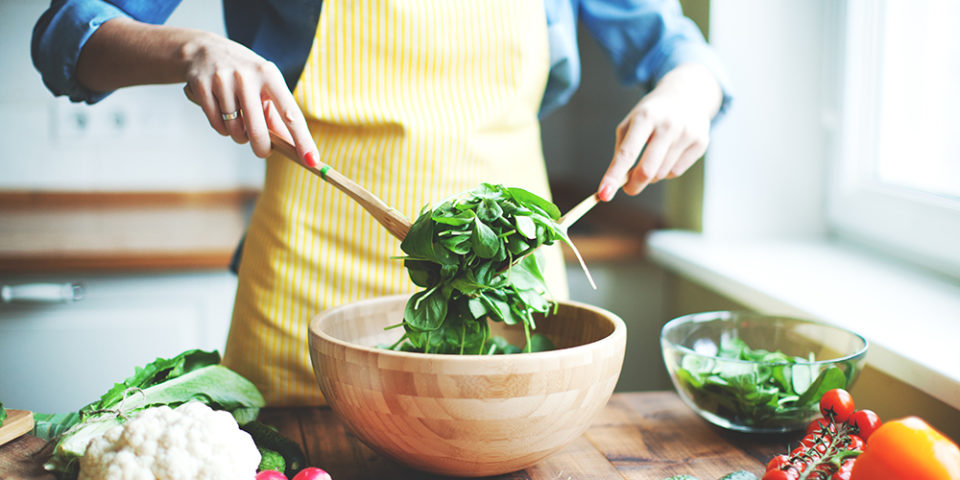Using nutrition to prevent cancer
It’s common to see news articles and ads touting a new ‘superfood’ that claims superb benefits, including cancer prevention. The truth is, ‘superfood’ is a marketing term, not a medical one – there is no such concept in medical nutritional science. Nonetheless, the thought that certain foods are better than a basic healthy diet has stuck, and it’s true that you can find certain strong benefits when using nutrition to prevent cancer.
Registered dietitian Finley Nadler explained that while diet is an important step in cancer prevention, it isn’t as simple as just adding ‘superfoods’ to your diet. It’s far more about having a well-rounded diet that focuses on a variety of healthy foods and using everyday nutrition to prevent cancer.
Certain foods can make cancer more likely to develop
“Carcinogens are classified according to a series of levels of risk, from things that we know cause cancer, those that can possibly or probably cause cancer, those that we can’t prove one way or the other, and then items that are not causes of cancer,” said Nadler.
Most of what we have definitively linked to the development of certain cancers – like cigarette smoking, diesel exhaust, air pollution and certain pesticides – are not types of food. However, there is one group of foods that has been linked directly to the development of colorectal cancer and stomach cancer: processed meats like hot dogs, bacon, cured ham, sausages, and canned or deli-style meat.
Further down the list, classified as probably having a link to the development of colorectal, prostate and pancreatic cancers, is red meat, such as beef, lamb or pork.
Choosing not to consume these foods – replacing red meat with chicken or fish, for example – lowers your chance of developing those linked cancers. But there are other nutritional steps you can take, too. The best step is changing up your eating habits to focus on plants.
Plant-based diets offer a variety of options for healthy nutrition
“Eating a diet rich in whole grains, vegetables, fruits and beans is essential when it comes to using nutrition to prevent cancer,” said Nadler. “There are many types of plant-based diets and a variety of options for people who want to choose healthier food options without giving up the foods they love.”
Options for a plant-based diet include:
- Vegan. In a vegan diet, absolutely no animal products are consumed. Ideally, a vegan diet focuses on a diversity of foods including fruits, vegetables, legumes, pulses, nuts, grains and seeds.
- Lacto-ovo vegetarian. This is a primarily vegetarian diet that allows for the consumption of eggs and dairy products, two animal-based products that don’t involve consuming meat. Honey is also allowed.
- Pescatarian. A pescatarian diet only allows the consumption of fish and other seafood in what is otherwise a vegetarian diet.
- “Flexitarian” or semi-vegetarian. A primarily vegetarian diet that allows for small amounts of animal products and meat.
“The main focus of your meal should be on foods that come from plants,” said Nadler. “We like to recommend these diets to patients because plant-based diets come with a lot of benefits – longevity, lower body mass index (BMI), reduced inflammation and risk of diseases like heart disease and type 2 diabetes, and of course… it lowers your risk of cancer.”
It’s all about the phytochemicals
Phytochemicals (often called ‘phytonutrients’) are produced by plants, and research has shown they offer many benefits to the human body. They have the potential to:
- Strengthen and stimulate the immune system
- Reduce the types of inflammation most linked to cancer growth
- Slow the growth rate of cancer cells
- Help with DNA repair
“If you’ve ever seen a magazine article that referenced nutritional benefits from foods and mentioned, say, lycopene in tomatoes or the allicin in garlic helping to fight a cold, what those articles are really talking about is phytochemicals,” said Nadler.
The best way to maximize your phytochemical intake is to do what is often called ‘eating the rainbow.’ Build a plant-based diet with as many different colors in your fruits and veggies as possible. Toss chopped bell peppers into your salad, throw a serving of spinach into your morning smoothie or scrambled eggs, snack on blueberries with almonds when you hit that mid-morning slump instead of pouring another cup of coffee… the possibilities are endless.
“Every meal should have a fruit, a vegetable, or ideally both,” said Nadler. “Make sure half your plate is those healthy fruits and vegetables, one quarter for whole grains, and the last quarter for proteins, whether that means legumes or meat.”
Those with a sweet tooth may find having a sweet fruit for dessert, like apple slices or mango, can help them get that sweetness they’re searching for while still taking in nutrients.
Every healthy food is a superfood as part of a balanced diet
There’s no such thing as a real ‘superfood,’ but healthy vegetables, fruits, whole grains, and proteins work together to create a powerhouse team, using nutrition to prevent cancer.
“I also recommend adding regular exercise into your daily life and getting 7–8 hours of sleep per night,” said Nadler. “It can be as simple as a half-hour walk after dinner, taking the stairs instead of the elevator or spending some time hiking with family instead of watching TV. You can do this! Start with these small changes around what you eat and go from there.”
Find the care you need, close to home
Our primary care physicians provide well visits and everyday care when you need it with compassion and expertise.
Find Primary Care Near You

